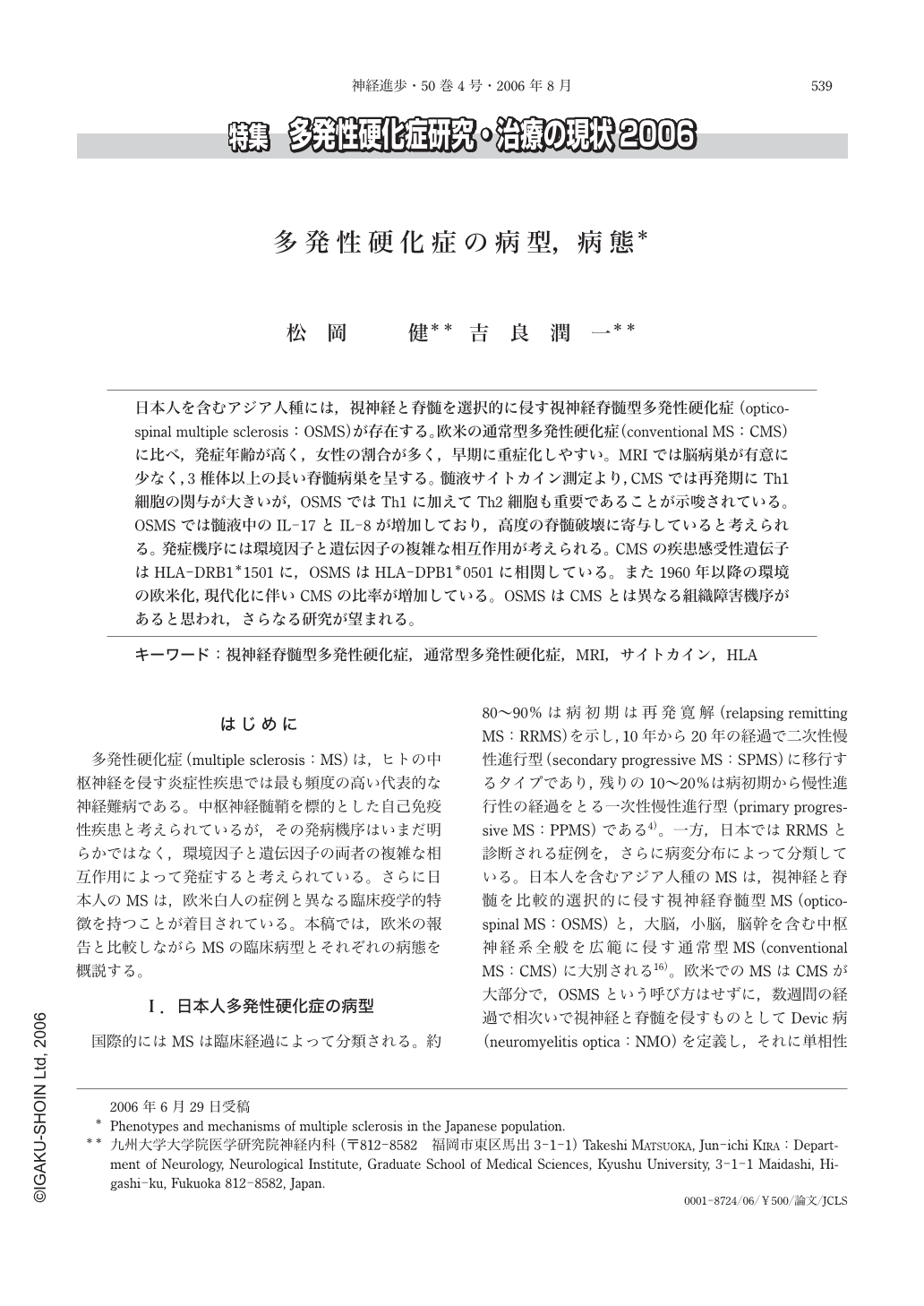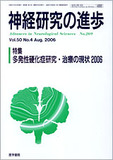Japanese
English
- 有料閲覧
- Abstract 文献概要
- 1ページ目 Look Inside
- 参考文献 Reference
日本人を含むアジア人種には,視神経と脊髄を選択的に侵す視神経脊髄型多発性硬化症(opticospinal multiple sclerosis:OSMS)が存在する。欧米の通常型多発性硬化症(conventional MS:CMS)に比べ,発症年齢が高く,女性の割合が多く,早期に重症化しやすい。MRIでは脳病巣が有意に少なく,3椎体以上の長い脊髄病巣を呈する。髄液サイトカイン測定より,CMSでは再発期にTh1細胞の関与が大きいが,OSMSではTh1に加えてTh2細胞も重要であることが示唆されている。OSMSでは髄液中のIL-17とIL-8が増加しており,高度の脊髄破壊に寄与していると考えられる。発症機序には環境因子と遺伝因子の複雑な相互作用が考えられる。CMSの疾患感受性遺伝子はHLA-DRB1*1501に,OSMSはHLA-DPB1*0501に相関している。また1960年以降の環境の欧米化,現代化に伴いCMSの比率が増加している。OSMSはCMSとは異なる組織障害機序があると思われ,さらなる研究が望まれる。
Multiple sclerosis(MS)is an inflammatory demyelinating disease of the central nervous system. Compared with MS in Caucasian populations, MS in Asians including Japanese is characterized by the selective and severe involvement of the optic nerve and spinal cord;called“opticospinal”type MS(OSMS).
OSMS generally has a higher age at onset and a higher female to male ratio than conventional MS(CMS). OSMS is also characterized by frequent relapses, severe disability, relatively rapid progression and the occurrence of a progressive course is less common. In an MRI study, the frequency of OSMS patients fulfilling McDonald's MRI criteria and showing Gadolinium-enhancing brain lesions was low while longitudinally extensive spinal cord lesions that extended over three vertebral segments was frequent in OSMS. Cell counts and total protein concentrations in the cerebrospinal fluid(CSF)were significantly higher in OSMS than CMS. By analysis of intracellular interferon γ and interleukin 4 production in CD4-positive T cells from peripheral blood, a significant T-helper-1-cell(Th1)shift(a higher intracellular ratio of interferon γ to interleukin 4)throughout the relapse and remission phases was found in OSMS;whereas in CMS, Th1 shift was seen only in the relapse phase. On the other hand, in CSF, CMS showed an increase of Th1 cells at relapse while OSMS showed an increase in both Th1 and Th2 cells. By cytokine and chemokine assays of CSF, it became clear that the IL-17/IL-8 system in CSF was markedly activated in OSMS. Significant positive correlations with the CSF/serum albumin ratio as well as CSF protein concentration were found for IL-8 and IL-17. Moreover, lengths of spinal cord lesions on MRI significantly correlated with IL-8 and IL-17 levels;however, only IL-8 showed a significant correlation with the EDSS score. IL-17 is produced by autoreactive memory T cells and induces IL-8 production in a variety of cells. IL-8 acts as a chemokine for neutrophils as well as T cells. In autopsied spinal cords from OSMS patients, many neutrophils were seen to infiltrate the severely damaging spinal cord lesions. Activation of the neutrophil-recruiting IL-17/IL-8 axis is characteristic for OSMS and appears to contribute to the development of severely destructive spinal cord lesions.
Although the mechanisms of MS remain unclear, it is thought to be developed by complicated interactions of environmental factors and genes. CMS in Japanese has been shown to have a significant association with the HLA-DRB1*1501 allele, which is the same association seen in Caucasian patients with MS. By contrast, OSMS has a significant association with HLA-DPB1*0501 allele. A sharp rise in the ratio of CMS to OSMS has been found in Japanese people born after the 1960s, suggesting that the modernization that occurred after the 1960s in Japan has had modifying effects on MS susceptibility and phenotypes. In Japan, epidemiological surveys have shown that there is a small but significant north-to-south gradient of MS prevalence rates, as seen in the temperate zones of the USA and Australia, while the rates of the prevalence of OSMS don't differ greatly between southern and northern areas. This suggests that environmental factors varying with latitude play a role in the development of CMS, as seen in Caucasian and Japanese populations, whereas their contribution to the development of OSMS may be minimal.
OSMS is thus likely to have a distinct immune-mediated mechanism that is not operative in CMS.

Copyright © 2006, Igaku-Shoin Ltd. All rights reserved.


